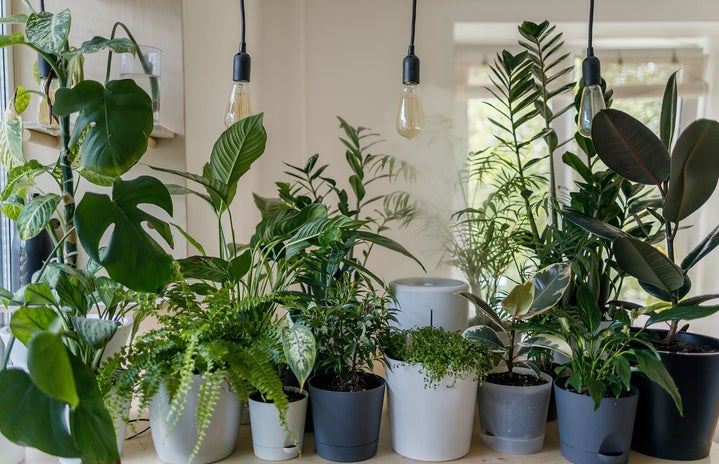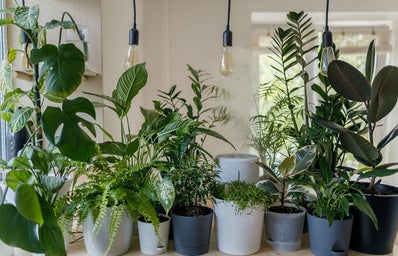Warmer temperatures, melting snow and blooming flowers – spring is right around the corne which means that it is the perfect time to start becoming a plant parent. As a certified plant parent, words cannot describe my excitement for the new season ahead as my plants have started to come out of their winter dormancy and show new signs of growth.
Have you ever wanted to start buying plants but find plant care rather daunting? This is the perfect guide for you. From light considerations to beginner-friendly plant suggestions, I am here to pass on my plant knowledge to you or at least help you in developing a green thumb.
These are some beginner-friendly (and affordable) plants that you can start with:
- Peace Lily – these gorgeous flowering plants don’t require direct sunlight and they communicate when they need watering! But here’s a disclaimer, when they’re thirsty, they droop very dramatically so don’t be alarmed, they’ll perk back up once they’ve been watered.
- Snake Plant – a very common and low-maintenance plant as it can tolerate most light conditions and require less watering. This is a great plant for people who are forgetful.
- Pothos (also known as the Devil’s Ivy) – similar to snake plants are also very low-maintenance and tolerant to infrequent watering. This plant is especially gorgeous since it grows into a gorgeous trailing vine.
- ZZ Plants – truthfully, these plants are basically indestructible. Out of all my plants, this is the one I neglect the most and somehow I’m seeing three new signs of growth and I can’t remember the last time I watered it.
Here are ten factors to consider when caring for plants indoors:
1. Light Requirements
This is one of the most important factors to consider for different plants as some plants thrive in bright, indirect light but others may prefer lower light levels. Therefore, it is important to assess the light conditions of your plant’s home. The easiest way to do this is to open up the app you never thought you’d need; the compass app. If you’re relying on using natural light from your windows, the different directions of your windows indicate how much light you’ll get.
In the Northern Hemisphere, south-facing windows receive the most direct sunlight during the day and north-facing windows receive the least natural light. South-facing windows are normally ideal for most plants, however, east-facing and west-facing windows are your next best option, but try to avoid plants that require plenty of light. Additionally, I would highly encourage you to avoid placing your plants right next to your window, especially at a south-facing window, otherwise you may risk burning your plants due to the intense direct sun.
2. Watering
Many beginners often either overwater or underwater their plants which can create stressful conditions for plants and can lead to their downfall. Researching plants before buying them is important so that you can learn and establish their ideal watering schedules, however, a general and safe rule of thumb is to get your finger knuckle-deep to touch and feel how dry the soil is. For many beginner plants, when the first inch of soil is dry, it’s likely time for watering.
Here’s a hot tip, for succulents and snake plants, neglect is often better than keeping a close eye to avoid overwatering as these plants. Sometimes I’ve gone two weeks without watering these types of plants and they somehow seem to love it.
3. Potting/Soil
First, when you buy a plant from the store, try to avoid immediately repotting them (unless they desperately need it). Plants need time to get used to the conditions of your home since they aren’t massive fans of change. Stressing them out less increases their chance of survival.
If you’re going to repot your plants, please make sure the pots have drainage holes on the bottom for the excess water to spill out. Most decorative pots do not have drainage holes so I would strongly advise beginners to avoid them.
As for soil, most beginner-friendly plants prefer well-draining soil. You can obtain this by purchasing a bag of potting soil and perlite and creating a ratio of 1 part perlite to 2 parts soil. This can be eyeballed.
4. Other Tips
Plants prefer conditions that are well-ventilated. Try to avoid placing your plants too close to your heater, air conditioner or even next to drafty windows as again, this can put a lot of stress on your plants.
If the humidity levels in your room or apartment are too low, you can increase the humidity by purchasing a humidifier from Facebook Marketplace given the fact that new ones are quite expensive. You can keep it turned on to the lowest setting for a few hours during the day. Hot tip – use a smart plug to set a timer for your humidifier to be turned on and off to control how long the device is on for (and ensure you do not leave it on…it happens).

